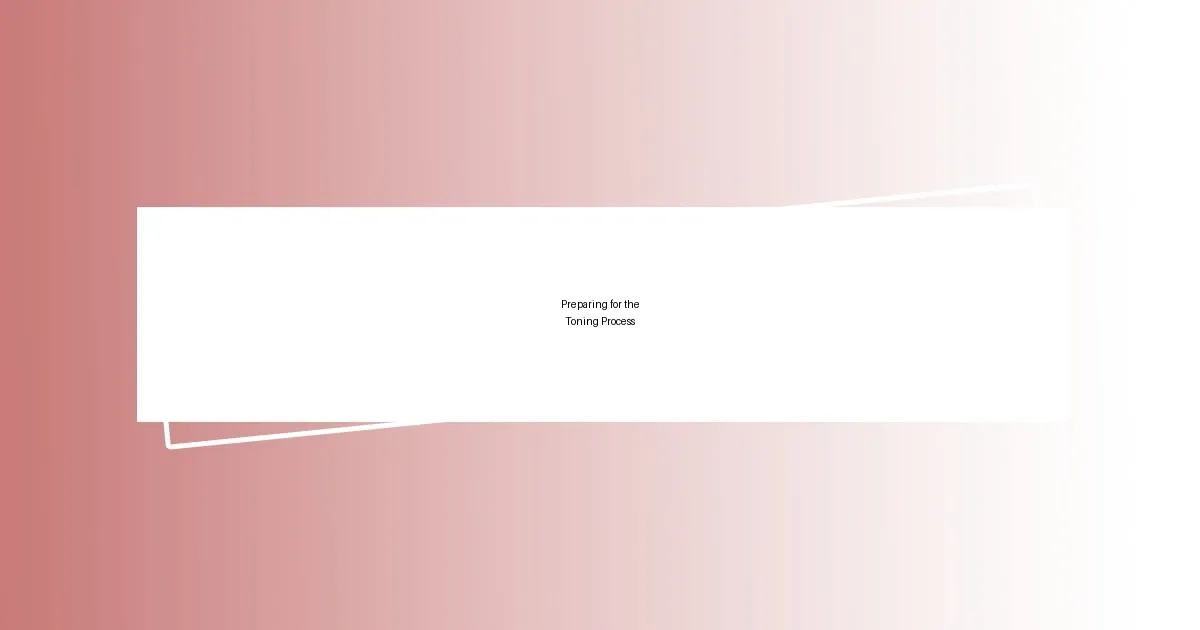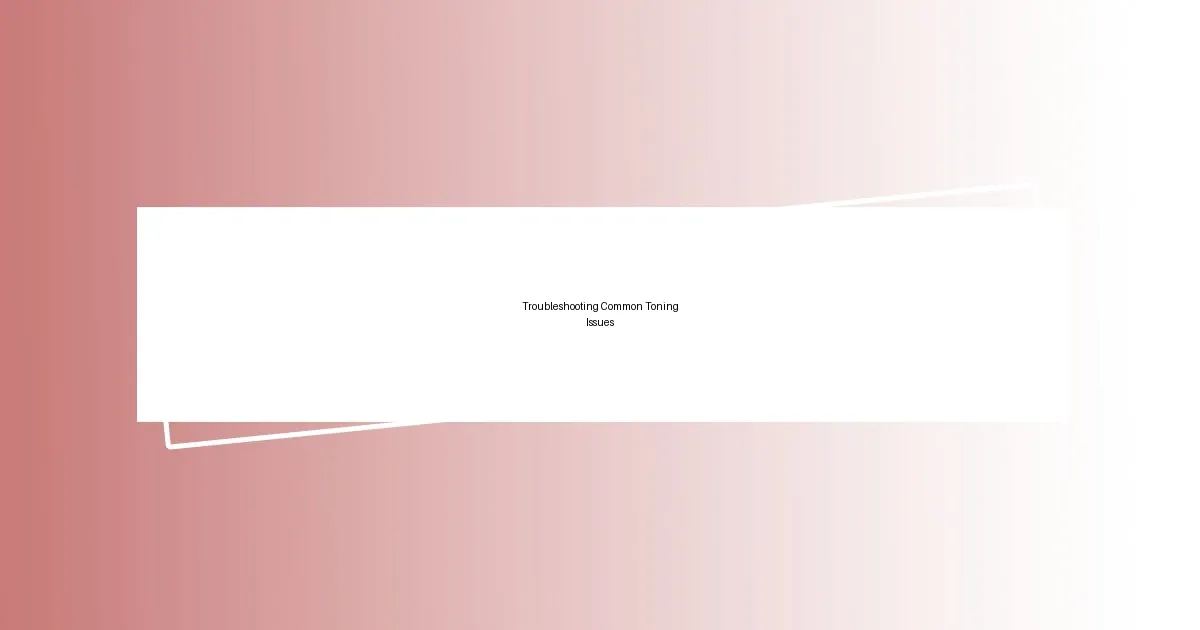Key takeaways:
- Understanding toning techniques is essential for creating desired moods and emotional impacts in photographs, distinguishing between color toning and monochrome toning.
- Choosing the right toning products involves personal exploration, testing for compatibility, and aligning choices with one’s artistic vision.
- Documenting experiments and seeking feedback from others enhances skill development and results in more cohesive and impactful artwork.
- Regularly revisiting and refreshing older works helps maintain a consistent style while allowing for creative evolution.

Understanding Toning Techniques
Toning techniques can transform the aesthetic of a photograph. For me, it’s about creating a mood that resonates with my vision. I remember experimenting with a cool blue tone on a summer landscape; it completely shifted the way the scene felt, giving it a dreamlike quality that just captivated me. Have you ever played with color grading and been surprised by the emotions it evokes?
When delving into toning, it’s essential to understand the difference between color toning and monochrome toning. Color toning involves adding hues to the highlights, midtones, or shadows of an image, while monochrome toning focuses on a single color throughout the photo. I find that color toning allows for more flexibility in expressing creative intent. Have you tried adjusting the tones in your photos to see how it alters the viewer’s experience?
Mastering toning techniques takes practice and a willingness to experiment. I often revisit older images and re-tone them, discovering fresh perspectives I hadn’t noticed before. It’s like rediscovering a piece of art; can you relate to that feeling of seeing something familiar through a new lens?

Choosing Toning Products
Choosing the right toning products is a crucial step in enhancing your images. I’ve had my fair share of trial and error with different tools, but determining what works best for my style makes all the difference. I once invested in a high-end filter that promised stunning results, but I found it didn’t complement my aesthetic at all. The lesson there? Not all products will resonate with your unique vision, so always test before committing to a purchase.
Here’s a quick guide to help you choose the right toning products:
- Determine Your Style: Identify whether you prefer warm or cool tones, as this will guide your product selection.
- Read Reviews: Check out what other photographers are saying about the products you’re considering.
- Try Before You Buy: If possible, use free trials or demo versions to gauge compatibility with your workflow.
- Consider Your Medium: Different toning products work better with various types of images, so assess whether you’re shooting in digital or film.
- Trust Your Instincts: Ultimately, go with what feels right for you—your intuition is often your best guide.
I can’t stress enough how personal this journey is. Each product you choose should resonate with your artistic voice. Let your intuition lead the way, and I promise you’ll discover tools that amplify your creative expression.

Preparing for the Toning Process
Preparing for the toning process is an essential step that sets the stage for the creative journey ahead. When I first began toning, I remember feeling overwhelmed by the options available. It helped to outline the specific look I wanted to achieve, which guided my choices. Having a clear vision not only made the process smoother but also heightened my excitement for what was to come.
Gathering the right materials is equally vital. I like to keep a dedicated space with my software running and my images loaded, ready for exploration. Having everything organized means I can focus more on the artistic side rather than searching for tools mid-process. It’s amazing how a clutter-free environment can spark creativity; have you ever noticed how your best ideas flow when you’re not distracted?
Lastly, I find it helpful to mentally prepare myself for the experiment. I often take a moment to envision the transformations I want to make. This brief pause helps align my thoughts with my desired outcome. It’s like preparing for a performance; the excitement builds, and I’m ready to unleash my creativity. How do you prepare for your artistic sessions?
| Preparation Step | Personal Insight |
|---|---|
| Define Your Vision | Having a clear goal makes the process more focused and enjoyable. |
| Organize Tools | A dedicated workspace eliminates distractions, enhancing creativity. |
| Mental Preparation | Visualizing the outcome helps align my thoughts for better results. |

Applying Toning Techniques Effectively
Applying toning techniques effectively can truly elevate your work. One thing I’ve learned is that experimentation is key. I often set aside dedicated time to play with different settings and adjustments, allowing myself to explore unexpected results. Do you ever find joy in trial and error? For example, I once stumbled upon an unusual color balance that completely transformed an ordinary landscape photo into something extraordinary. That serendipitous moment taught me that sometimes the best outcomes come from stepping out of your comfort zone.
When it comes to applying toning techniques, consistency is crucial. I make it a point to document each experiment, noting down the settings and the emotions that inspired my choices. This practice not only helps me remember what worked but also reminds me of the feelings I wanted to convey. Have you ever looked back at your previous works and thought, “What was I trying to express here?” Keeping a record allows me to refine my intuition, ultimately leading to a more cohesive body of work.
Finally, feedback is invaluable. I remember sharing a series of toned images with a close friend, eager for their thoughts. Their insights opened my eyes to subtle shifts in perception that I hadn’t considered. It reinforced the idea that collaboration can sharpen one’s skills, don’t you think? For me, applying toning techniques effectively means blending personal vision with input from others, resulting in images that resonate on multiple levels.

Evaluating Results After Toning
Evaluating the results after toning is where the magic truly unfolds. I often take a step back and let my work breathe before I analyze it. There’s something about giving my eyes a moment of rest that allows me to see the piece with fresh perspective. Have you ever looked at something you created after stepping away from it and thought, “Wow, did I really do that?” It’s during these moments of reflection that I often spot nuances I might have missed in the heat of the creative process.
I find it helpful to compare the toned version of my image with the original. This side-by-side evaluation helps me determine if the adjustments enhanced the piece as intended. I still remember the first time I noticed how a simple shift in exposure could highlight textures I hadn’t considered. It made me realize how critical it is to assess not just what I changed, but also what the change communicates to the viewer. What emotions does the toning evoke? Does it align with my original intention? These questions guide my assessment.
Finally, gathering feedback after evaluating my results is a game changer. I can recall an instance when I shared a toned portrait with a photography group. Their reactions made me realize how different aspects of the toning struck chords with various viewers. This feedback was invaluable, reminding me that art is not just about personal satisfaction but also about connection. How do you approach feedback? In my experience, it’s a blend of my evaluative process and others’ insights that leads to truly impactful final pieces.

Troubleshooting Common Toning Issues
When troubleshooting common toning issues, there are a few key problems that can crop up. One time, I noticed my images were coming out too warm, giving them an almost unnatural glow. In trying to correct it, I found that adjusting the color balance in small increments made a world of difference. Have you ever tackled a color problem only to feel like you were making it worse? Sometimes, simply pacing myself and observing the changes closely keeps me on track.
A challenge I often encounter is uneven toning. I vividly recall a landscape photo where I overdid it in the shadows and accidentally lost detail in the highlights. The solution? I learned to apply adjustments in layers, using masks to control where the toning would impact the image most. This method allowed me to balance out the tones, keeping the image dynamic without sacrificing important details. Don’t you think it’s incredible how layering techniques can bring back life to an image?
Additionally, there are times when the toning results in a distraction rather than enhancement. I remember a project where my vivid colors overshadowed the subject, pulling the viewer’s attention away. By revisiting my intentions, I stripped back some of the more aggressive tones. Simplifying the palette not only strengthened the focus but also allowed the emotion of the moment to shine through more clearly. Have you had experiences where less truly became more? It’s often in those moments of reflection that I find clarity in my work, leading me to more impactful imagery.

Maintaining Toned Results Over Time
When it comes to maintaining toned results over time, consistency is crucial for me. I remember an exhibition where I displayed several pieces, and one artwork stood out due to its vibrant, consistent toning. I realized then that regular practice and revisiting my toning techniques helped me produce work that looked cohesive. Have you ever noticed how a thematic approach can create a signature style? That’s what I strive for—recognizable elements that tie my work together.
I’ve also found that documenting my toning processes can be incredibly helpful. After completing a successful piece, I jot down the exact settings and adjustments I made. One time, I duplicated a favorite tone from an earlier photo months later by referencing my notes. It felt like uncovering a secret recipe! It’s that kind of detail that not only preserves my results but also sharpens my skills over time. How often do you document your creative methods? In my experience, revisiting those notes can spark new ideas and reinforce successful techniques.
Lastly, revisiting and refreshing my work periodically is something I cherish. I recall an instance when I decided to tone an old piece with a new approach, and it completely redefined my vision. This practice helps me stay connected to my evolving style while solidifying my original intentions. Have you ever breathed new life into an old creation? It’s like a second chance to express oneself—an opportunity to refine and maintain the essence of what first inspired you.














